HOME >> BUSINESS, OP-ED
Five-year plans still needed for China’s development
By Yan Yilong Source:Global Times Published: 2015-8-2 22:08:01
Focus now more on broader, overall progress

Illustration: Luo Xuan/GT
The 13th Five-Year Plan has been a hot topic in the past few weeks, with media reports saying the Communist Party of China (CPC) will meet in October to discuss the new plan. There has also been speculation that the country's economic growth target may be lowered for the 13th Five-Year plan period (2016-20).
But why does a market-oriented China need a plan for national development? Doesn't economic planning, a key characteristic of centralized economies, run counter to market forces? There are voices saying China should abandon its five-year plans, which were initiated in 1953.
But this is actually a misunderstanding of the five-year plans. For instance, the 12th Five-Year Plan was totally different from the country's First Five-Year Plan. In today's China, in which the concept of the free market has become deeply rooted, the five-year plans no longer direct the way in which the market and private enterprises operate; they consider how the government should offer public services and implement macroeconomic regulation.
China's First Five-Year Plan in 1953 adopted a Soviet-style planned economy model, setting guidelines for production and investment.
But the Sixth Five-Year Plan in 1981 saw significant changes from previous five-year plans, in order to map out China's economic and social development as the country implemented its reform and opening-up to the outside world. In the Sixth Five-Year Plan, mandatory targets for production and investment were removed, while guidance for economic and social development were included.
The second big change in China's five-year plans came in 1996. The CPC had said in 1992 that China was moving toward a socialist market economy, and the market, while still under State macroeconomic control, should be the basic means of allocating resources. Some analysts said the Ninth Five-Year Plan (1996-2000) bore similarities to the US president's State of the Union address because it touched upon various aspects of China's development including social and cultural aspects and did not set mandatory economic targets for the period. They said it showed the central government's priorities of supporting economic and social development, with less of a focus on State intervention.
Subsequent five-year plans have further evolved, and in the 12th Five-Year Plan (2011-15), the focus was on public services and social development, such as reducing pollution, rather than resource allocation or guiding the market.
The upcoming 13th Five-Year Plan may see another big change, with the CPC having announced in 2013 that China will deepen its economic reform to ensure that the market plays a "decisive" role in allocating resources.
The new five-year plan will not run counter to the market market, but it may promote better development of the market economy.
The plan will offer private investors a good chance to see the government's priorities and make better plans themselves. This is especially important during China's economic transition, given that policy priorities such as eliminating outdated production capacity will have a widespread influence on low-end manufacturers.
The new five-year plan will also serve as a guideline for government work in the next five years.
As well as socialist countries, some capitalist countries such as France have drawn up national economic plans. In the case of India, looking at the country's 12th Five-Year Plan (2012-17), there are similarities with the plan China used to develop its economy decades ago. At the time, the national economic plan in China mainly focused on achieving rapid economic growth, but current five-year plans in China focus more on a wide range of issues including education, science, the environment and social development.
The improved five-year plans in China will help to promote better development of the economy, given that sustained economic growth cannot be achieved without efforts such as technological and social progress. The average annual economic growth in India from its first to 11th five-year plan period was 5.7 percent, compared with 10.8 percent in China during its first 11 five-year plan periods. The higher economic growth can be used as evidence to show China's five-year plans are not out of date and can continue to serve as a guideline to map out China's economic and social development.
The author is a research fellow with the Center for China Studies at Tsinghua University. bizopinion@globaltimes.com.cn
Posted in: Expert assessment, Biz Comments